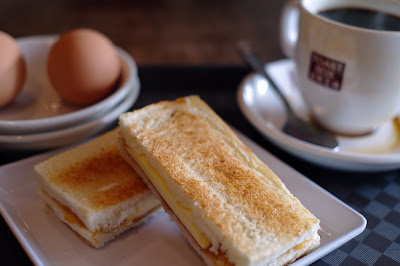As with my previous forays into turkish delight and marshmallow, kaya is one of those things you just buy. It's barely a foodstuff, it's just stuff. Making it doesn't really cross your mind. Marmite as opposed to marmalade, if you will.
Unless you're me.
My elegant and cosmopolitan neighbour actually laughed and said gently "you're hilarious!" when I told her I was going to try and make kaya. Not that's hilarious, but specifically you're hilarious. Not quite sure how I feel about that - d'you think she refers to me as the eccentric British woman next door? I hope not. Mind you, she did have homemade turkish delight and marshmallows forced upon her. In significant quantities.
My interest in making kaya is prompted by a book I'm reading, The Tiger in the Kitchen by Cheryl Lu-Lien Tan (see description here). As with most projects, the kaya-making process kicked off with shopping. But this wasn't soul-destroying supermarket shopping. No, no, buying groceries at the Tekka Centre wet market in Little India is an altogether more sensory and satisfying experience.
First stop: the fruit and veg aisle for pandan leaves. These are used in lots of local dishes, both sweet and savoury. They have a characteristic flavour and scent, and the green colouring is used to make some violently artificial-looking desserts among other things.
When we first arrived in Singapore, someone enlightened me about the oddly pungent smell in some of the grubbier taxis: drivers pile bundles of pandan leaves on the back window ledge to deter 'roaches. Cheaper than a regular valet and some baygon traps I guess. So unfortunately I always associate the smell of pandan with the sinking feeling that I'm in an infested taxi - but I was determined to plough on regardless.
 |
| bundles of pandan leaves right at the back |
Next were the coconut guys. They are always so cheerful and it's such a novelty to me to be able to buy freshly grated coconut for mere pennies - I'll take any excuse to go to their stall.
So, on to the recipe. I trawled the internet for hints and tips, and decided to loosely base my kaya on Cheryl's story about making it with her grandmother (with some added details gleaned from the web to be borne in mind).
I mixed 100g of golden caster sugar into five eggs, a cup of coconut cream (squeezed and strangled from the half kilo of freshly grated coconut - amazingly therapeutic) and 10 pandan leaves tied in a bundle. Onto the wok steamer went the bowl and... hmmm... that would appear to be it.
There followed a series of disappointments.
Firstly, nothing happened for a long time. I'd read that the tricky bit is preventing the sugar from catching and burning, but there was no chance of that happening here. While Cheryl's kaya took just 45 minutes, I was eventually ready to throw in the towel and put the whole episode down to experience after and hour and a half. It hadn't gone pandan green or sugar brown (those are the two shades of kaya that I've seen in jars), it just looked like congealed egg with some leaves floating on the top.
However, having read online that it might look like wet scrambled eggs (and that many people assume failure and throw it out at this point) I was prepared for this unappetising stage. As instructed I spooned off excess water and blitzed the cooled mixture with a wand-blender before bottling and refridgerating.
The other slightly deflating aspect was that I felt I'd broken kaya's spell. This legendary local delicacy seems to be, basically, steamed egg custard. The milk may be from a coconut, and the pandan adds a subtle flavour, but at the end of the day it's still just steamed egg custard. Mass-produced kaya has a slightly granular texture which reminds me of undercooked Scottish Tablet mixture, so I was anticipating bubbling vats of mysterious potion similar to that. Not so with homemade kaya - just soft, sweet, steamed egg custard. I felt like I'd found hidden Christmas gifts; they were okay and I still wanted to have them on the big day, but part of me wished that they were still a mystery.
But the proof of the pudding is in the eating and all that, so how would our Saturday morning gourmet kaya toast breakfast compare with the "real" thing: a lightly boiled egg or two (the whites barely set) doused with soy sauce, a white toast sandwich of butter and kaya, and some kopi or teh (super strong with condensed milk).
 |
| a commercial kaya toast set |
 |
| homemade, with our beloved old-school hawker-style coffee set and melamine plates! |
Well, the Guatemalan beans roasted by Papa Palheta were as delicious as coffee beans can be (we omitted the condensed milk, preferring our coffee black). The stars of the show were definitely the eggs with artisan local soy sauce from Kwong Woh Hing - these were a true revelation. And who can argue with thick white bread and real butter now and again? My kaya was smooth, soft and pale, and definitely tasted like it ought to, but I confess to missing the graininess of the mass-produced stuff.
I concede that I may still have some way to go in perfecting the art of kaya - perhaps I made it too creamy, and maybe some caramelised sugar would improve the colour. But, on the other hand, I'm the shizzle at steamed egg custard these days.
Now, onto more important matters. Ridding my apartment of eau de minicab. Otherwise I might get a reputation as that eccentric British woman with the foosty-smelling flat.

Linking in with Sweet Saturday at the Gingerbreadblog.com







Wow! Great post. You should seriously try to get it published in a food journal or blog.
ReplyDeleteYou're awesome! I love this type of cooking and the research and curiosity that goes into it. Your kaya looks so yummy, and Singapore looks like a foodie paradise. I wish we could get freshly shredded coconut around here.
Aw Lydia! THANK YOU! That's a really encouraging thing to say, and I appreciate it. I'm rather new to this whole thing (as you can see) and using it as a spring board to publication hadn't crossed my mind (which is daft really as I used to work in editorial in a past life - d'oh!). Maybe one day I'll be brave enough to attempt submitting a column to someone. but in the meantime, thank you very much for the encouragement. (And you're right, Singapore = food heaven!)
ReplyDeleteSuch a great post of your kaya journey!
ReplyDeleteI love you being adventurous and going for it - I just wish I could come food shopping with you!
I can't wait for you to cook us some exotic things when you come home!!! This is so exciting.
ReplyDelete